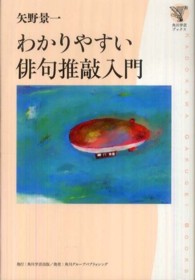- ホーム
- > 洋書
- > 英文書
- > Nature / Ecology
Full Description
A witty, engaging, in-depth, and evidence-based look at how cannabis affects our brains.
Pot, weed, ganja, chronic: whatever you call it, cannabis can profoundly affect the human body and brain. In The Science of Weed, renowned physician, psychiatric researcher, and Yale neuroscience professor Godfrey Pearlson offers a deep dive into the true facts of cannabis, covering everything from its botany and chemistry to its impacts on psychology and human behavior. Taking a neutral approach to the subject, Pearlson emphasizes evidence-based research to separate the reality from the hype about this complicated plant.
Pearlson explores the origins of cannabis, its interactions with humans throughout history, and its medicinal applications. His clear explanations of the plant's chemical structure and composition, as well as the internal cannabinoid system of the human body, ensure readers gain a real understanding of the mechanisms behind a subjective high. Moving beyond its effects on humans, Pearlson discusses the plant's collective impact on economics and the health care system, demonstrating how scientific scrutiny can bring enlightened reason to the contentious debates surrounding the drug.
By objectively explaining the science behind weed, this book provides a thorough education for anyone who wants to know how cannabis affects our brains and bodies. It allows for an unbiased consideration of public policy on legalization, and helps readers weigh risks and benefits to make their own decisions about using it.
Contents
Foreword
Joe Dolce
Introduction
Chapter 1. Good Science and Bad Science
Chapter 2. Holi
Chapter 3. Ethnobotany, Botany, and Archaeology
Chapter 4. Neuroscience
Chapter 5. Psychology + Human Behavior
Chapter 6. Epidemiology
Chapter 7. Toxicology
Chapter 8. Chemistry, Chemical Analysis, and Extraction: Terpenes to Tinctures
Chapter 9. Medical Marijuana and Clinical Trials
Chapter 10. Economics
Chapter 11. A Scientific Approach to Cannabis Legalization
Acknowledgments
References
Index







